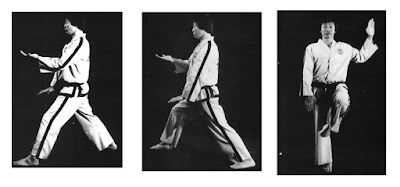 |
| Sources: Kinetic Dragon Tutorials, Returning Wave Systems |
Now the question is: how do you get into this position? The hint the form gives you is the two palm pressing blocks, a set which appears in several other forms.
Option 1: Arm Drag
For the first possibility, I'm going to steal another idea from Karate Culture: using the dual palm blocks to get an arm drag.
 |
| Source: Karate Culture |
This is a simple application to learn, and arm drags are useful to set up all sorts of other techniques. But if you are a forms purist, you may dislike how this technique requires you to close one of your hands. Keeping this in mind, I will provide a second interpretation.
Option 2: From a failed arm lock
An instructor once showed me a locking application for two palm pressing blocks. I can't find an exact replica online, but the description of it is this:
- Imagine an opponent grabs your right lapel. Circle your right hand over and down (1st palm pressing block) and then up again (upper hand for 2nd palm pressing block). This rotates the opponent's arm so that the back of their elbow points upwards
- Your left hand at first comes up to block an attack with the back of the wrist (upper hand for 1st palm pressing block) or as a spearhand to the opponent's throat. It then comes down to press into the back of the opponent's elbow (2nd palm pressing block)
- From here you can try to drag them to the ground, or knee strike them (one-legged stance)
 |
| Left: Application for the 2nd palm pressing block, upper hand raising the opponent's (twisted) arm, lower hand pushing their elbow down. Right: Following up with a knee and elbow strike, another use for the one-legged stance. Sources: Martial Arts 101, Phil Schroeder |
What if your opponent pulls away their arm as you attempt the lock? From here, reach over their right shoulder and quickly transition in the control position shown at the top of this post.

No comments:
Post a Comment